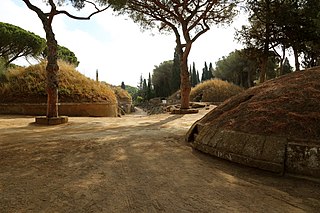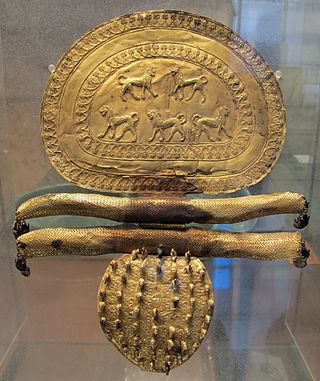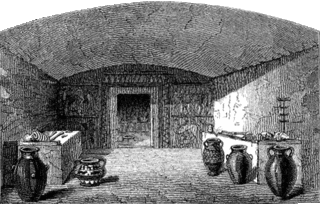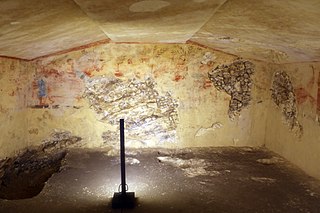
Cerveteri is a comune (municipality) in the Metropolitan City of Rome Capital, in the Italian region of Lazio. Known by the ancient Romans as Caere, and previously by the Etruscans as Caisra or Cisra, and as Agylla by the Greeks, its modern name derives from Caere Vetus used in the 13th century to distinguish it from Caere Novum.

The Tomb of the Roaring Lions is an archaeological site at the ancient city of Veii, Italy. It is best known for its well-preserved fresco paintings of four feline-like creatures, believed by archaeologists to depict lions. The tomb is believed to be one of the oldest painted tombs in the western Mediterranean, dating back to 690 BCE. The discovery of the Tomb allowed archaeologists a greater insight into funerary practices amongst the Etruscan people, while providing insight into art movements around this period of time. The fresco paintings on the wall of the tomb are a product of advances in trade that allowed artists in Veii to be exposed to art making practices and styles of drawing originating from different cultures, in particular geometric art movements in Greece. The lions were originally assumed to be caricatures of lions – created by artists who had most likely never seen the real animal in flesh before.

The Sarcophagus of the Spouses is a tomb effigy considered one of the masterpieces of Etruscan art. The Etruscans lived in Italy between two main rivers, the Arno and the Tiber, and were in contact with the Ancient Greeks through trade, mainly during the Orientalizing and Archaic Period. The Etruscans were well known for their terracotta sculptures and funerary art, largely sarcophagi and urns. The sarcophagus is a late sixth-century BCE Etruscan anthropoid sarcophagus that was found at the Banditaccia necropolis in Caere and is now located in the National Etruscan Museum of Villa Giulia, Rome.

Etruscan art was produced by the Etruscan civilization in central Italy between the 10th and 1st centuries BC. From around 750 BC it was heavily influenced by Greek art, which was imported by the Etruscans, but always retained distinct characteristics. Particularly strong in this tradition were figurative sculpture in terracotta, wall-painting and metalworking especially in bronze. Jewellery and engraved gems of high quality were produced.

A false door, or recessed niche, is an artistic representation of a door which does not function like a real door. They can be carved in a wall or painted on it. They are a common architectural element in the tombs of ancient Egypt, but appeared possibly earlier in some Pre-Nuragic Sardinian tombs known as Domus de Janas. Later they also occur in Etruscan tombs and in the time of ancient Rome they were used in the interiors of both houses and tombs.

The Tomb of Orcus, sometimes called the Tomb of Murina, is a 4th-century BC Etruscan hypogeum in Tarquinia, Italy. Discovered in 1868, it displays Hellenistic influences in its remarkable murals, which include the portrait of Velia Velcha, an Etruscan noblewoman, and the only known pictorial representation of the daemon Tuchulcha. In general, the murals are noted for their depiction of death, evil, and unhappiness.

The Tomb of the Whipping is an Etruscan tomb in the Necropolis of Monterozzi near Tarquinia, Lazio, Italy. It is dated to approximately 490 BC and named after a fresco of two men who flog a woman in an erotic context. The tomb was discovered and excavated in 1960 by Carlo Maurilio Lerici. Most of the paintings are badly damaged.

The Tomb of the Leopards is an Etruscan burial chamber so called for the confronted leopards painted above a banquet scene. The tomb is located within the Necropolis of Monterozzi, near Tarquinia, Lazio, Italy, and dates to around 470–450 BC. The painting is one of the best-preserved murals of Tarquinia, and is known for "its lively coloring, and its animated depictions rich with gestures," and is influenced by the Greek-Attic art of the first quarter of the fifth century BC.

The Tomb of the Bulls is an Etruscan tomb in the Necropolis of Monterozzi near Tarquinia, Lazio, Italy. It was discovered in 1892 and has been dated back to either 540–530 BC or 530–520 BC. According to an inscription Arath Spuriana apparently commissioned the construction of the tomb. It is named after the two bulls which appear on one of its frescoes. It is the earliest example of a tomb with complex frescoes in the necropolis, and the stylistic elements are derived from Ionian Greek culture. Along with the frescoes of the Tomb of the Whipping these paintings are relatively rare examples of explicit sexual scenes in Etruscan art, which were far more common in Ancient Greek art.

The Monterozzi necropolis is an Etruscan necropolis on a hill east of Tarquinia in Lazio, Italy. The necropolis has about 6,000 graves, the oldest of which dates to the 7th century BC. About 200 of the tomb chambers are decorated with frescos.

The tomb known as the Regolini-Galassi tomb is one of the wealthiest Etruscan family tombs in Caere, an ancient city in Italy approximately 50–60 kilometres (31–37 mi) north-northwest of Rome. The tomb dates to between 680/675-650 BC. Based on the evidence of the tomb's architecture and its contents, it was built by a wealthy family of Caere. The grave goods included with the two decedents included bronze cauldrons and gold jewellery of Etruscan origin in the Oriental style. The tomb was discovered in 1836 in modern-day Cerveteri in an undisturbed condition and named after the excavators, general Vincenzo Galassi and the archpriest of Cerveteri, Alessandro Regolini. Both of these men had previous experience opening and excavating tombs in the area of Caere.

The Tomb of Hunting and Fishing, formerly known as the Tomb of the Hunter, is an Etruscan tomb in the Necropolis of Monterozzi near Tarquinia, Lazio, Italy. It was discovered in 1873 and has been dated variously to about 530–520 BC, 520 BC, 510 BC or 510–500 BC. Stephan Steingräber calls it "unquestionably one of the most beautiful and original of the Tarquinian tombs from the Late Archaic period." R. Ross Holloway emphasizes the reduction of humans to small figures in a large natural environment. There were no precedents for this in Ancient Greek art or in the Etruscan art it influenced. It was a major development in the history of ancient painting.

The Tomb of the Triclinium ) is an Etruscan tomb in the Necropolis of Monterozzi dated to approximately 470 BC. The tomb is named after the Roman triclinium, a type of formal dining room, which appears in the frescoes of the tomb. It has been described as one of the most famous of all Etruscan tombs.

The Grotta Campana or Tomba Campana is an Etruscan tomb in Veii, which was rediscovered in 1843 by Giampietro Campana. For a while it was considered to contain the oldest known Etruscan frescoes. It is named after the owner of the land where and when the tomb was discovered. Because of a lack of inscriptions, it is unknown who was buried in this tomb. The tomb has not been dated with any precision.

Monuments in the Basilica of Santa Maria del Popolo are tombs and funerary monuments ranging from the 15th to the 19th centuries. Since its rebuilding in the 1470s by Pope Sixtus IV the Basilica of Santa Maria del Popolo was one of the favourite burial places for members of the papal aristocracy, clergy and literati. Foreign artists were also buried in the church due to its location near their favourite quarter in Rione Campo Marzio. The high number of tombs and monuments makes the basilica a whole museum of sculpture as Jacob Burckhardt phrased it in his famous guide of Italian art in 1855. Besides the tombs in the side chapels and the choir there are many other funeral monuments in the aisles and the transept. During the centuries several monuments were demolished and others were relocated to give place to newer ones.

The Tomb of the Blue Demons is an Etruscan tomb in the Necropolis of Monterozzi near Tarquinia, Italy. It was discovered in 1985. The tomb is named after the blue and black-skinned demons which appear in an underworld scene on the right wall. The tomb has been dated to the end of the fifth century BC.

The Tomb of the Dancers or Tomb of the Dancing Women is a Peucetian tomb in Ruvo di Puglia, Italy. It was discovered in the Corso Cotugno necropolis in November 1833. The date of its construction is uncertain, dates ranging from the end of the fifth century BC to the mid-fourth century BC have been proposed. In any case, the tomb's frescoes are the oldest example of figurative painting in Apulia, together with another tomb in Gravina di Puglia. The Peucetians borrowed the practice of painting tombs from the Etruscans, who had an important influence on their culture. The tomb is named after the dancing women which appear on the frescoes in the tomb. The panels with the frescoes are now exhibited in the Naples National Archaeological Museum, inv. 9353.

The Tomb of the Augurs is an Etruscan burial chamber so called because of a misinterpretation of one of the fresco figures on the right wall thought to be a Roman priest known as an augur. The tomb is located within the Necropolis of Monterozzi near Tarquinia, Lazio, Italy, and dates to around 530-520 BC. This tomb is one of the first tombs in Tarquinia to have figural decoration on all four walls of its main or only chamber. The wall decoration was frescoed between 530-520 BC by an Ionian Greek painter, perhaps from Phocaea, whose style was associated with that of the Northern Ionic workers active in Elmali. This tomb is also the first time a theme not of mythology, but instead depictions of funerary rites and funerary games are seen.

Etruscan architecture was created between about 900 BC and 27 BC, when the expanding civilization of ancient Rome finally absorbed Etruscan civilization. The Etruscans were considerable builders in stone, wood and other materials of temples, houses, tombs and city walls, as well as bridges and roads. The only structures remaining in quantity in anything like their original condition are tombs and walls, but through archaeology and other sources we have a good deal of information on what once existed.

The Tomb of Judgement, also known as the Great Tomb of Lefkadia is an ancient Macedonian tomb of the Hellenistic period in Mieza, noted for its monumental painted facade. It was probably built at the beginning of the third century BC.




















